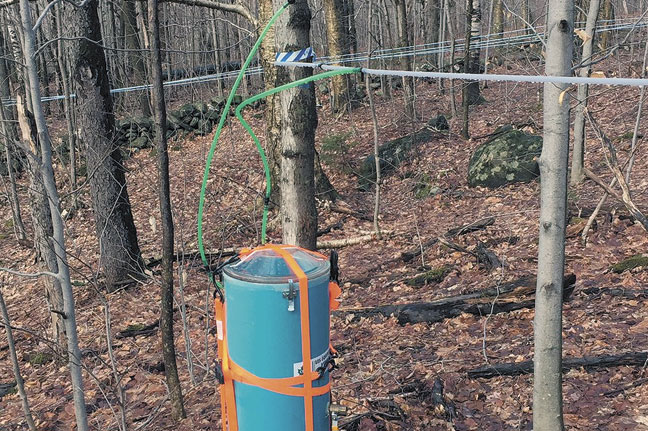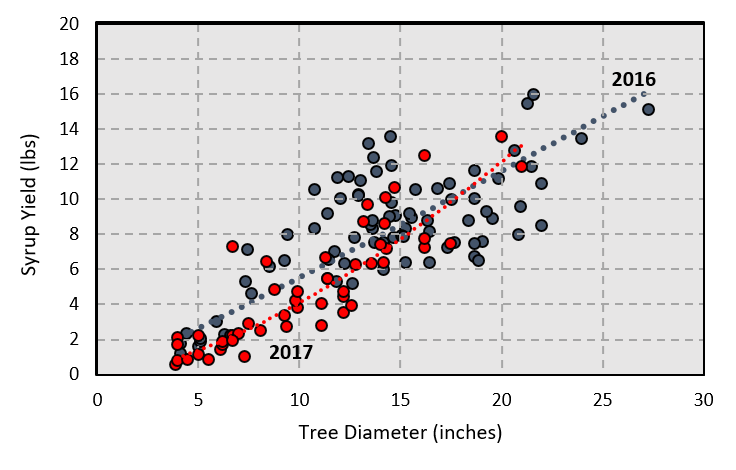UVM Proctor Page
Understanding the relationship between tree size and yield
It's a relationship that's often overlooked by sugarmakers
By TIMOTHY PERKINS, MARK ISSELHARDT, ABBY VAN DEN BERG | UVM PROCTOR MAPLE RESEARCH CENTER AND UVM MAPLE EXTENSION, UNIVERSITY OF VERMONT UNDERHILL CTR., VERMONT | FEB. 5, 2018
There are several important factors that affect the yield of sap from trees during the production season.
These generally fall into four categories: tree characteristics, tapping, vacuum, and spout/tubing sanitation.
On tubing, it is sometimes difficult to observe the impacts each of these has on sap yield, by doing controlled research studies it is possible to discern the relationships among certain characteristics and practices.
In fact, some of the common sayings in the maple industry such as “strive for five, no more than ten” and “5% more sap for each 1” Hg vacuum” come directly from such research.
One relationship that is sometimes overlooked is the one between tree size and yield.
With buckets, it was fairly easy to keep track of trees that were good producers and those that didn’t produce so well. It was also easy to observe the effect of tree size on yield. With the prevalence of tubing however, there is the temptation to tap every tree that is reachable, even if it is quite small, because…”it’s there…might as well tap it.”
However small trees generally produce fairly modest quantities of sap, and sometimes the expense associated with tapping these trees means only a minimal net profit. Since every connection on a tubing system is a potential leak, and because every tree produces, in addition to sap, some amount of gas during a thaw which needs to be evacuated by the pump to keep the vacuum level high, time might be better spent doing few, more productive taps, and therefore keeping vacuum levels on a smaller number of trees higher. Perhaps by thinning out a thick stand of small trees, the residual crop trees will grow faster and achieve tappable size sooner and increase their size (and syrup yield) faster. Finally, it is important to understand at what point trees should (and more importantly, SHOULDN’T) be tapped in terms of sustainable production practices.
In order to develop models of tree size and yield to answer some of these questions, we measured the sap volume and sugar content from a wide range of tree sizes during the 2016 and 2017 seasons.
Different areas of the UVM Proctor Maple Research Center (PMRC) forest were used each year. We used sap collection chambers (Figure 1) connected to vacuum pumps. Tapholes were drilled to 1.5” and connected to a dropline leading to a single chamber for sap to collect in.
Vacuum was maintained at about 25” Hg throughout the spring season. Collection was stopped at the time that the UVM PMRC production ended.
Sap depth was measured as needed during the season to keep chambers from overflowing and converted to volume. Sugar content was measured with a Misco digital refractometer. Syrup yields were calculated from volume and sap sugar content using the revised Jones Rule of 87.1 and are expressed in lbs/tap.
The 2016 seasons had overall similar levels of average production, although sap volumes were higher in 2016, but sap sugar content was lower than that found in 2017.
In general, there was a strong relationship between tree diameter and syrup yield. Smaller trees produced far less syrup than larger trees in both years, with trees under 5” diameter typically producing in the range of 1-2 lbs of syrup, or only about half that of a tree 10” diameter.
As size increases beyond 10”, syrup yield continues to increase nearly linearly. Intuitively, under vacuum sap collection conditions at least, this makes a lot of sense.
Producers can conceptually think of trees as being similar to pipes that are stuck upright in the ground, but filled with a wood matrix filled with tiny pores containing water. As the pipe gets larger, the number of pores increases, and the volume of water that can be held in those pores also increases.
At least this would be the case for trees that don’t have a lot of heartwood or compartmentalization from previous tapping.
Even then, the volume of wood in the upper portion of the stem and in branches far exceeds that in the stem, so the non-conductive wood (heartwood and tapping scars) would have only a relatively modest impact on sap volume in the stem.
While these results will be used in several of our studies on maple production sustainability and economics over the next few years, the overall immediate take-home messages from this work are that:
• small trees produce relatively little sap
• the relationship between tree size and yield is fairly consistent and tends to be linear
• in general, each 1” increase in tree diameter results in approximately 2 gal more sap or 0.67 lbs more syrup.

































